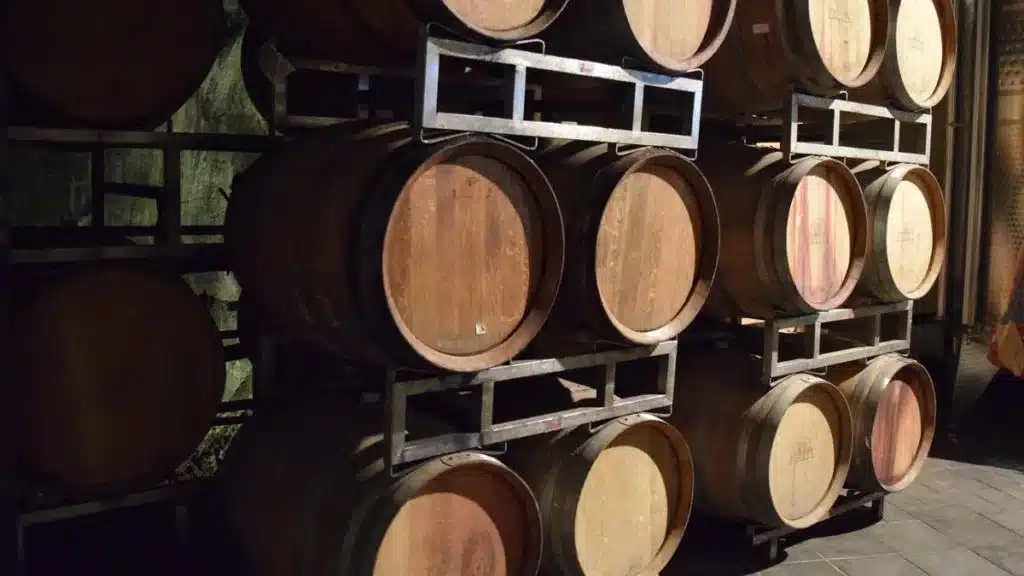The journey of wine, from its humble beginnings as a tiny bud on a vine to the delicious liquid in your glass. In this blog post, we’ll take you step-by-step through this fascinating winemaking process.
The Lifecycle of a Grape Vine
Wine’s journey begins in a vineyard, where the grapevines patiently cycle through the seasons. The journey to a bottle of wine starts with the spring bud break, where small buds on the vine start to swell and eventually burst into leaf.
Spring: Bud Break and Flowering
As spring warms the earth, grapevines awaken from their winter dormancy, and the first buds of the new season appear. These buds eventually develop into tiny flowers, which, once pollinated, will become the grapes we harvest.
Summer: The Growing Season
As the days lengthen and temperatures rise, the vine focuses on photosynthesis, using sunlight to grow and mature the grapes. This period is known as the growing season. The grapes change color, a process known as veraison, signaling the start of the ripening phase.
Harvesting: When and How It Happens
The ripened grapes are then harvested, a step that requires careful timing and consideration. The exact moment of harvest can significantly impact the wine’s flavor, acidity, and sweetness.
The Art of Timing
Determining the perfect moment to harvest is a delicate balance. The winemaker must consider the grape’s sugar levels, acidity, and tannins, which contribute to the wine’s taste, color, and structure.
Handpicking vs. Machine Harvesting
The method of harvesting also plays a significant role. Handpicking is gentle and allows for careful selection but can be labor-intensive. Machine harvesting is efficient but may include more stems and leaves
The Fermentation Process
Following the harvest, the grapes are de-stemmed and crushed to extract the juice, which is then ready for fermentation. This is the process where sugars are converted into alcohol by yeast, transforming grape juice into wine.
Primary and Secondary Fermentation
Primary fermentation can take anywhere from a few days to a couple of weeks. During this time, yeast consumes the sugar in the grapes, creating alcohol. Then, in secondary fermentation, the yeast converts malic acid into softer lactic acid, giving wine its smooth taste
The Magic of Maceration
For red wines, a process called maceration occurs during fermentation. The juice is left in contact with the grape skins, seeds, and stems, extracting color, flavors, and tannins
Aging and Bottling
Once fermentation is complete, the next step in winemaking is to age the wines. The aging process allows the wine to develop complex flavors and aromas that weren’t present or noticeable at the end of fermentation.
The Role of Barrels
Many wines are aged in oak barrels. The oak can add new flavors and textures to the wine. The size of the barrel, the type of oak used, and the length of aging all influence the wine’s final characte
Filtration
Finally, the wine is ready for bottling. It’s typically filtered first to remove any remaining solids.
The Final Step: Bottling
Once the wine has been aged to satisfaction, the final step in winemaking is bottling. This process, often overlooked, is critical to the quality and longevity of the wine. Ensuring that the wine is bottled properly can make the difference between a mediocre wine and one that will dazzle your friends and family1.
Is It Wine Yet?
The first thing to note is that the wine should only be bottled when it’s clear and stable. Clarity is essential, as murky wine is unattractive and may develop off-flavors over time. For nearly all red wines and most kit wines, careful racking and the passage of time (ideally nine to 12 months) will achieve this. However, some white wines, blushes, and fruit wines may need a bit of assistance through fining or filtration to achieve clarity1.
Heat and Cold Stabilization
Before bottling, it’s also crucial to ensure the wine is both heat and cold stabilized. Heat stabilization involves removing protein hazes that can reappear when the wine rises above cellar temperature. This is particularly important for white wines, which can become hazy when warmed or aged. Cold stabilization, on the other hand, involves chilling the wine to precipitate excess tartaric acid before bottling. While most reds naturally achieve both forms of stabilization, white wines, blushes, and fruit wines may require additional steps1.
Avoiding Re-fermentation
It’s also crucial to ensure the wine is fully fermented to dryness before bottling, unless a sweet wine is desired. If the wine has residual sugar or is sweetened, steps need to be taken to stabilize the wine and prevent re-fermentation in the bottle, which can cause explosions and mayhem in the cellar. This usually involves the addition of potassium sorbate and maintaining safe levels of sulfur dioxide1.
Preparing the Bottles
Preparing the bottles for the wine is another key step. Bottles should be clean, unchipped, and ideally, recycled for a more economic solution. The process of delabeling and cleaning can be accomplished by soaking in a hot soda solution, brushing with a bottle brush, and rinsing thoroughly. The bottles should then be sterilized and stored upside down until ready to use1.
Choice of Bottle
The choice of bottle shape is often determined by tradition, though this can vary depending on the winemaker’s preference. Typically, Cabernets are bottled in square-shouldered Bordeaux bottles, while Chardonnays are in slope-shouldered Burgundies. However, for less fussy or larger-scale producers, these preferences can give way to using whatever bottles are at hand. It’s important to note that clear glass bottles should be avoided unless the wine will not come into contact with direct sunlight, which can brown the bottle’s contents1.
In conclusion, winemaking is a process that requires patience and a keen eye for detail. From the vineyard to the bottle, each step is significant in crafting the final product that we enjoy. So the next time you sip on a glass of wine, take a moment to appreciate the journey it has taken to reach you.
Click here to learn more about Vasanti Estate Winery
References:
- “Viticulture: An Introduction to Commercial Grape Growing for Wine Production.” WineSkills. Accessed July 3, 2023. http://www.wineskills.co.uk/tourism-marketing/introduction-to-viticulture.
- “Grape Harvest: What Does It Mean To Be Picked At The Right Time?” Wine Folly. Accessed July 3, 2023. https://winefolly.com/tutorial/grape-harvest-what-does-it-mean-to-be-picked-at-the-right-time.
- “The Winemaking Process.” Wine Country Getaways. Accessed July 3, 2023. https://www.winecountrygetaways.com/winemaking-process.
- “Bottling, Start to Finish.” WineMakerMag. Accessed July 3, 2023. https://winemakermag.com


